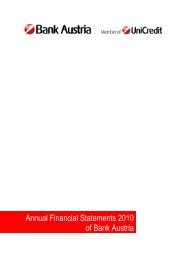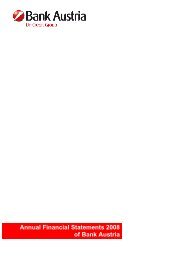Annual Financial Statements 2011 of Bank Austria
Annual Financial Statements 2011 of Bank Austria
Annual Financial Statements 2011 of Bank Austria
Create successful ePaper yourself
Turn your PDF publications into a flip-book with our unique Google optimized e-Paper software.
Management Report<br />
Management Report (CONTINUED)<br />
� Italy is an industrial country (and a founding member <strong>of</strong><br />
the G7) and is playing in a different league. The country has<br />
always been able to access capital markets, even though<br />
interest rate spreads rose to record levels in autumn <strong>2011</strong><br />
(+435 bp to 677 bp). This is not explained by country specifics<br />
but was due to market views that Italy, a large economy,<br />
shares the typical problems <strong>of</strong> the “southern peripheral countries”.<br />
Unit labour costs in industry increased strongly in<br />
recent years, with an impact on price competitiveness (which<br />
the new government aims to correct through liberalisation).<br />
But Italy is a major European trading partner. Italy’s main<br />
problem is the legacy burden <strong>of</strong> public debt amounting to<br />
119% <strong>of</strong> GDP. Debt accumulated in the 1970s and 1980s,<br />
reaching a peak ratio <strong>of</strong> 122% in 1995. Given Italy’s size, this<br />
requires an annual debt rollover <strong>of</strong> € 341 bn (in 2012, compared<br />
with a total amount <strong>of</strong> € 1,400 bn for the euro area as<br />
a whole); even a minor widening <strong>of</strong> spreads has an immediate<br />
impact on the budget through interest expenditure. The new<br />
government’s budget consolidation measures and its programme<br />
to restore growth and improve competitiveness are<br />
making progress. Even if Italy’s GDP probably contracted by<br />
1.3% in <strong>2011</strong>, according to data issued by the European<br />
Commission, plans to achieve a balanced budget in 2013 are<br />
seen as feasible. This would correspond to a large primary<br />
surplus (balance <strong>of</strong> revenue and expenditure excluding interest<br />
payments) <strong>of</strong> about 4%; in <strong>2011</strong>, Italy achieved a primary surplus<br />
<strong>of</strong> 1% <strong>of</strong> GDP. Based on the logic <strong>of</strong> rating agencies, the<br />
downgrades <strong>of</strong> Italy’s credit rating also affected banks and<br />
ultimately other companies which can tap capital markets.<br />
Terms and conditions for new issues in the current year have<br />
improved, and the rollover was based on shorter maturities to<br />
take advantage <strong>of</strong> the yield curve. As regards net financing<br />
flows, Italy is hardly dependent on external financing given the<br />
high level <strong>of</strong> private net assets. The consistent implementation<br />
<strong>of</strong> reforms which have been initiated, improved governance<br />
and close cooperation in Europe can restore confidence in<br />
financial markets. This is also reflected in a decline in interest<br />
rate spreads (down from the peak level in <strong>2011</strong> by 374 bp to<br />
304 bp). At 3.8% most recently, yields on 5-year Italian government<br />
bonds have been lower than those prevailing in the<br />
years 2006 to 2008, or even in 2002. In the years before the<br />
collapse <strong>of</strong> Lehman Brothers, yields even exceeded 5%.<br />
� Developments in Hungary are <strong>of</strong> special significance – not<br />
least for <strong>Bank</strong> <strong>Austria</strong> as an <strong>Austria</strong>n bank. Given the close<br />
links between the real economy and the banking sector in<br />
Hungary and neighbouring <strong>Austria</strong>, Standard & Poor’s used the<br />
Hungarian crisis <strong>of</strong> confidence as an important argument for<br />
downgrading the rating assigned to the Republic <strong>of</strong> <strong>Austria</strong><br />
shortly after the turn <strong>of</strong> the year. In Hungary, a number <strong>of</strong><br />
amendments to the Constitution and to the legal framework in<br />
<strong>2011</strong> were not entirely acceptable to the EU and the IMF, the<br />
country’s most important lender. The levy on banks introduced<br />
in 2010 was compounded by efforts to ease the solvency<br />
problems <strong>of</strong> private households through administrative procedures,<br />
placing a larger burden on banks which acted as lenders.<br />
The Home Protection Act passed in May <strong>2011</strong> among<br />
other things gave mortgage debtors the option <strong>of</strong> restructuring<br />
their debt at fixed exchange rates. In September the government<br />
went even further with the option <strong>of</strong> early repayment <strong>of</strong><br />
loans denominated in euro or foreign currency at a fixed mandatory<br />
conversion rate. The rules imply a loss <strong>of</strong> at least 25%<br />
on CHF-denominated loans and 15% on the restructuring <strong>of</strong><br />
euro-denominated loans – the total volume <strong>of</strong> foreign currency<br />
loans is about € 18 bn. In December <strong>2011</strong>, the government<br />
and the Hungarian <strong>Bank</strong>ing Association reached agreement on<br />
easing the burden on banks, permitting the latter to <strong>of</strong>fset up<br />
to 30% <strong>of</strong> the losses thereby incurred against the levy on<br />
banks in 2012. The unpredictable regulatory intervention in<br />
<strong>2011</strong> (and in the early part <strong>of</strong> 2012) nevertheless led to a<br />
sell-<strong>of</strong>f by international investors. Hungary’s country rating<br />
was moreover downgraded to speculative investment on<br />
24 November <strong>2011</strong>, which made the rollover <strong>of</strong> its foreign<br />
debt much more expensive, and the country was faced with a<br />
downward spiral <strong>of</strong> currency depreciation. Risk premiums rose<br />
to a peak <strong>of</strong> 660 basis points on 4 January 2012 (5-year CDS<br />
spreads) and a benchmark spread <strong>of</strong> 992 basis points for<br />
5-year government bonds (which reflects both a risk premium<br />
and the generally higher interest rate level). Based on a comparison<br />
<strong>of</strong> year-end data, the Hungarian forint depreciated by<br />
11.7% against the euro and by 14.2% against the Swiss<br />
franc. Hungary’s economic policymakers responded by taking<br />
countermeasures at the expense <strong>of</strong> domestic growth. While<br />
real economic growth in <strong>2011</strong> was 1.7%, we assume that<br />
2012 will see stagnation. The deleveraging process in the<br />
banking sector also contributed to this development. Lending<br />
volume stagnated in <strong>2011</strong> (+0.4% in euro terms). The proportion<br />
<strong>of</strong> non-performing loans (NPL ratio) rose to 14.5%,<br />
and several banks reported losses.<br />
From the middle <strong>of</strong> January 2012, the exaggerated reactions<br />
seen in financial markets reversed: from the end <strong>of</strong> <strong>2011</strong> to<br />
the end <strong>of</strong> February 2012, the Hungarian forint appreciated<br />
significantly (+9.0% against the euro/+8.3% against the<br />
<strong>Bank</strong> <strong>Austria</strong> · <strong>Annual</strong> <strong>Financial</strong> <strong>Statements</strong> <strong>2011</strong><br />
54
















